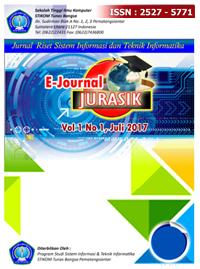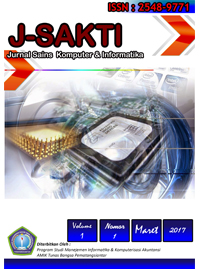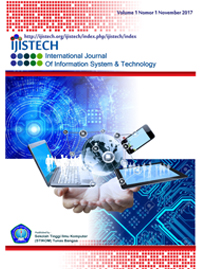Implementasi Algoritma K-Means Clustering dalam Menentukan Blok Tanaman Sawit Paling Produktif
Abstract
Full Text:
PDFReferences
E. Tarwaca and S. Putra, “Tanggapan Produktivitas Kelapa Sawit ( Elaeis guineensis Jacq . ) terhadap Variasi Iklim The Productivities Responses of Oil Palms ( Elaeis guineensis Jacq .) to Variation of Climate Elements,” vol. 4, no. 4, pp. 21–34, 2015.
R. Setiawan and N. Tes, “PENERAPAN DATA MINING MENGGUNAKAN ALGORITMA K-MEANS CLUSTERING UNTUK MENENTUKAN STRATEGI PROMOSI MAHASISWA BARU ( Studi Kasus : Politeknik LP3I Jakarta ),” vol. 3, no. 1, pp. 76–92, 2016.
B. M. Metisen and H. L. Sari, “ANALISIS CLUSTERING MENGGUNAKAN METODE K-MEANS DALAM PENGELOMPOKKAN PENJUALAN PRODUK PADA SWALAYAN FADHILA,” vol. 11, no. 2, pp. 110–118, 2015.
I. Parlina, A. P. Windarto, A. Wanto, and M. R. Lubis, “Memanfaatkan Algoritma K-Means dalam Menentukan Pegawai yang Layak Mengikuti Asessment Center untuk Clustering Program SDP,” CESS (Journal of Computer Engineering System and Science), vol. 3, no. 1, pp. 87–93, 2018.
M. G. Sadewo, A. P. Windarto, and D. Hartama, “Penerapan Datamining Pada Populasi Daging Ayam Ras Pedaging Di Indonesia Berdasarkan Provinsi Menggunakan K-Means,” InfoTekJar (Jurnal Nasional Informatika dan Teknologi Jaringan), vol. 2, no. 1, pp. 60–67, 2017.
M. G. Sadewo, A. P. Windarto, and A. Wanto, “Penerapan Algoritma Clustering dalam Mengelompokkan Banyaknya Desa/Kelurahan Menurut Upaya Antisipasi/ Mitigasi Bencana Alam Menurut Provinsi dengan K-Means,” KOMIK (Konferensi Nasional Teknologi Informasi dan Komputer), vol. 2, no. 1, pp. 311–319, 2018.
R. W. Sari, A. Wanto, and A. P. Windarto, “Implementasi Rapidminer dengan Metode K-Means (Study Kasus : Imunisasi Campak pada Balita Berdasarkan Provinsi),” KOMIK (Konferensi Nasional Teknologi Informasi dan Komputer), vol. 2, no. 1, pp. 224–230, 2018.
S. Sudirman, A. P. Windarto, and A. Wanto, “Data Mining Tools | RapidMiner : K-Means Method on Clustering of Rice Crops by Province as Efforts to Stabilize Food Crops In Indonesia,” IOP Conference Series: Materials Science and Engineering, vol. 420, no. 12089, pp. 1–8, 2018.
A. P. Windarto, “Implementation of Data Mining on Rice Imports by Major Country of Origin Using Algorithm Using K-Means Clustering Method,” International Journal of artificial intelligence research, vol. 1, no. 2, pp. 26–33, 2017.
A. P. Windarto, “Penerapan Data Mining Pada Ekspor Buah-Buahan Menurut Negara Tujuan Menggunakan K-Means Clustering,” Techno.COM, vol. 16, no. 4, pp. 348–357, 2017.
N. Sirait, “IMPLEMENTASI K-MEANS CLUSTERING PADA PENGELOMPOKAN MUTU BIJI SAWIT ( Studi Kasus : PT . Multimas Nabati Asahan ),” vol. 16, pp. 368–372, 2017.
DOI: http://dx.doi.org/10.30645/senaris.v1i0.39
Refbacks
- There are currently no refbacks.
 








